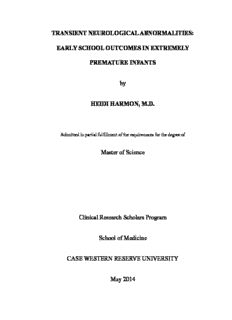Table Of ContentTRANSIENT NEUROLOGICAL ABNORMALITIES:
EARLY SCHOOL OUTCOMES IN EXTREMELY
PREMATURE INFANTS
by
HEIDI HARMON, M.D.
Submitted in partial fulfillment of the requirements for the degree of
Master of Science
Clinical Research Scholars Program
School of Medicine
CASE WESTERN RESERVE UNIVERSITY
May 2014
CASE WESTERN RESERVE UNIVERSITY
SCHOOL OF GRADUATE STUDIES
We hereby approve the thesis/dissertation of
Heidi Harmon, MD
candidate for the degree of Master of Science *.
Committee Chair
Douglas Einstadter, M.D
Committee Member
H. Gerry Taylor, Ph.D.
Committee Member
Deanna Wilson-Costello, MD
Date of Defense
March 26, 2014
*We also certify that written approval has been obtained
for any proprietary material contained therein.
TABLE OF CONTENTS
List of Tables……………………….……………………………………………… iv
List of Figures……………………….……...……………………………………… v
Acknowledgements………………………………………………………………… vi
List of Abbreviations………………………………………………..……………... vii
Abstract…………………………………………………………………………….. ix
Background and Significance……………………………………………………… 1
Hypotheses and Specific Aims…………………………………………………….. 4
Methods……………………………………………………………………………. 5
Study Population…………………………………………………………… 5
Data Collection……………………………………………………………...7
Data Analysis………………………………………………………………. 8
Results……………………………………………………………………………… 11
Aim 1………………………………………………………………………..11
Aim 2………………………………………………………………………..13
Aim 3………………………………………………………………………..20
Discussion………………………………………………………………………….. 34
Bibliography……………………………………………………………………….. 42
iii
LIST OF TABLES
Table 1: Social Demographic and Clinical Characteristics of Study Population….. 12
Table 2: Maternal Sociodemographic Characteristics……………………………... 13
Table 3: Infant and Toddler Developmental Testing and Neurological Exam…….. 14
Table 4: Characteristics of Each Assessment……………………………………….15
Table 5: Woodcock Johnson Tests of Cognitive Abilities………………………….17
Table 6: Woodcock Johnson Tests of Academic Abilities………………………… 18
Table 7: Motor Testing…………………………………………………………….. 19
Table 8: Child Behavior Checklist…………………………………………………. 20
Table 9: Longitudinal Growth Trajectories for Cognitive Outcomes………………21
Table 10: Longitudinal Growth Trajectories for Academic Outcomes……………. 23
Table 11: Longitudinal Growth Trajectories for Motor Outcomes………………... 28
Table 12: Longitudinal Trajectories for Behavior Problems………………………. 30
iv
LIST OF FIGURES
Figure 1: Consort Diagram………………………………………………................ 6
Figure 2: Classification Diagram of Neurological Exam………………………….. 11
Figure 3: Longitudinal Growth of IQ by Exam Group….......................................... 24
Figure 4: Longitudinal Growth of Verbal Comprehension Skills by Exam Group... 24
Figure 5: Longitudinal Growth of Concept Formation Skills by Exam Group…..... 25
Figure 6: Longitudinal Growth of Visual Matching Skills by Exam Group………. 25
Figure 7: Longitudinal Growth of Spatial Relations Skills by Exam Group……… 26
Figure 8: Longitudinal Growth of Letter Word Identification by Exam Group…… 26
Figure 9: Longitudinal Growth of Spelling Skills by Exam Group………………... 27
Figure 10: Longitudinal Growth of Math Skills by Exam Group…………………..27
Figure 11: Longitudinal Growth of Motor Skills by Exam Group………………… 29
Figure 12: Longitudinal Growth of Visual Motor Integration by Exam Group…… 30
Figure 13: Internalizing Behavior Problems over Time…………………………… 32
Figure 14: Externalizing Behavior Problems over Time…………………………... 33
Figure 15: Total Behavior Problems over Time…………………………………… 33
Figure 16: Attention Problems over Time………………………………………..... 34
v
ACKNOWLEDGEMENTS
My sincere appreciation and thanks go to all my mentors, past and present, who have
supported me in my career. I would like to thank H. Gerry Taylor, PhD, for all his
mentorship and access to his tremendous dataset. I would also like to thank Dr. Maureen
Hack, for her assistance in the concept design of this project. Special thanks go to Dr.
Dee Wilson for her constant encouragement and assistance with study refinement. I
would also like to give thanks to Nori Minich, MS, for all her assistance in statistical
analysis and project design. I would also like to thank Douglas Einstadter, PhD, for his
assistance with the completion of this thesis. I would also like to thank Dr. Richard
Martin for the opportunity to participate in the CRSP program with the help of the
division of neonatology T32 program. My most heartfelt thanks go to my husband,
Devon Harmon, for his patience and support throughout fellowship and this master’s
program. Lastly, I would like to thank all the families and children who agreed to
participate in this study.
FUNDING SUPPORT
A special thanks to the Rainbow Babies & Children’s Foundation for their
funding support through the Fellowship Research Award Program (FRAP).
vi
This educational program and thesis were supported by Grant Number T32 - NIH
5-T32-HD-060537-01. Its content are solely the responsibility of the author and
do not necessarily represent the official views of NIH.
vii
LIST OF ABBREVIATIONS
AB Neurologically Abnormal Group
AIC Akaike’s Information Criterion
ANOVA Analysis of Variance
ANCOVA Analysis of Covariance
BIA Brief Intellectual Ability
BOT2 Bruininks-Oseretsky Test of Motor Proficiency
BSID-2 Bayley Scales of Infant Development, 2nd Edition
CBCL Child Behavior Checklist
CP Cerebral Palsy
EP Extremely Premature
g Grams
IVH Intraventricular Hemorrhage
MDI Mental Development Index
MRI Magnetic Resonance Imaging
NN Neurologically Normal Group
PDI Physical Development Index
viii
PVL Periventricular Leukomalacia
PMA Postmenstrual Age
SES Socioeconomic Status
SD Standard Deviation
TNA Transient Neurological Abnormalities
VLBW Very Low Birth Weight
VMI Visual Motor Integration
ix
Transient Neurological Abnormalities:
Early School Outcomes in Extremely Premature Infants
Abstract
by
HEIDI HARMON, MD
Extremely premature infants often have transient neurological abnormalities (TNA)
during infancy and the implications of TNA for school age functioning are unclear. The
aim of this study was to determine if the neurological exam at 8 and 20 months predicts
cognitive, behavioral, and motor outcomes in early elementary school. A cohort of 124
infants, admitted in 2001-2003, were examined in early childhood and then yearly
between kindergarten and 2nd grade. Analysis with cross-sectional study methods and
mixed modeling, demonstrated an increased risk of cognitive problems, academic
problems, and motor problems in children with TNA and persistent neurological
abnormalities (AB) compared to those in the neurologically normal (NN) group. There is
not an accelerated rate of skill acquisition in the TNA group or AB group to allow for
catch-up growth compared to the NN group. Children with TNA represent a commonly
unrecognized group with high risk of difficulties at school entry.
x
Description:The aim of this study was to determine if the neurological exam at 8 and 20 months predicts cognitive, behavioral, and motor outcomes in early elementary school. A cohort of 124 infants, admitted in 2001-2003, were examined in early childhood and then yearly between kindergarten and 2 nd grade.

